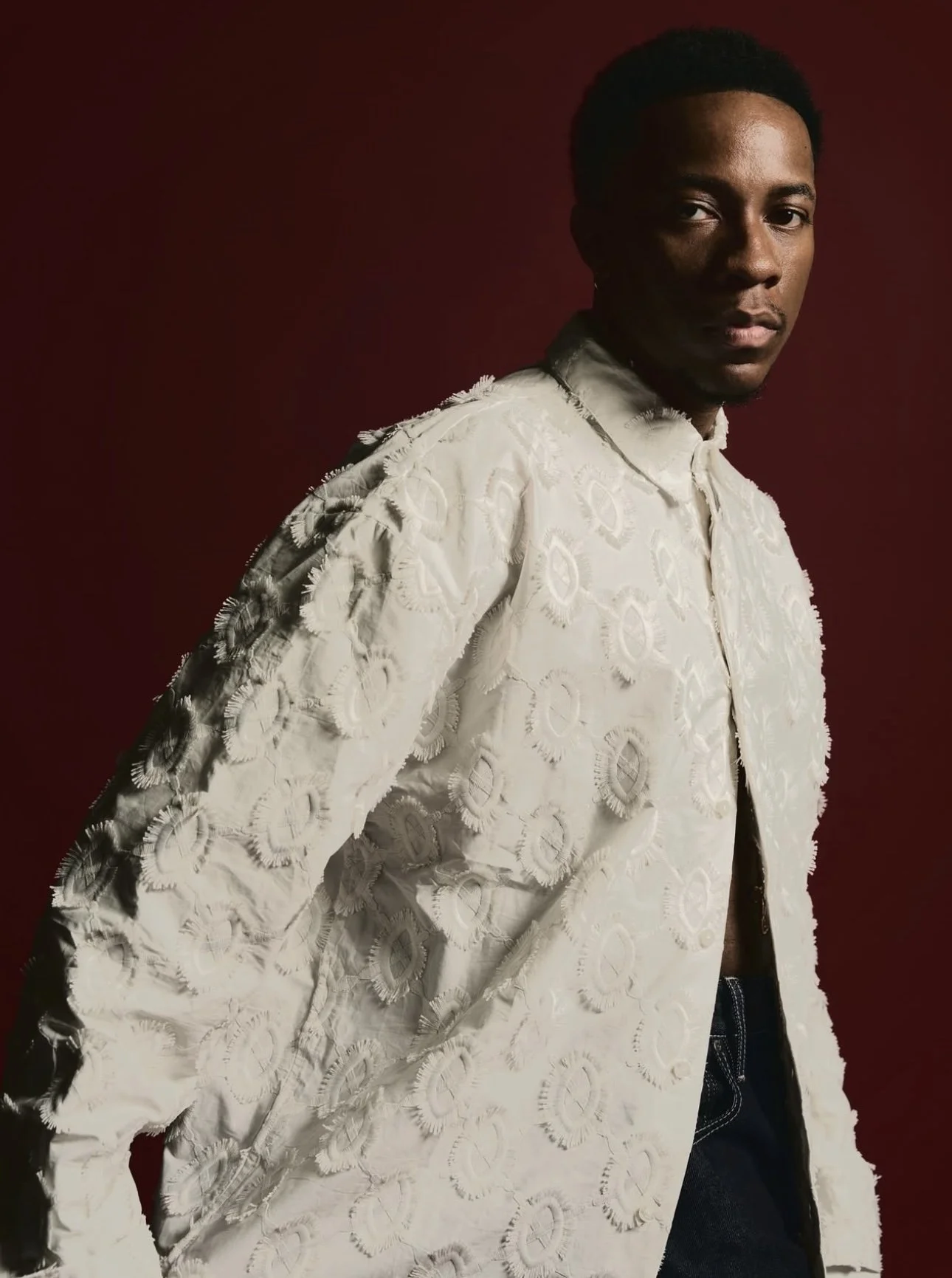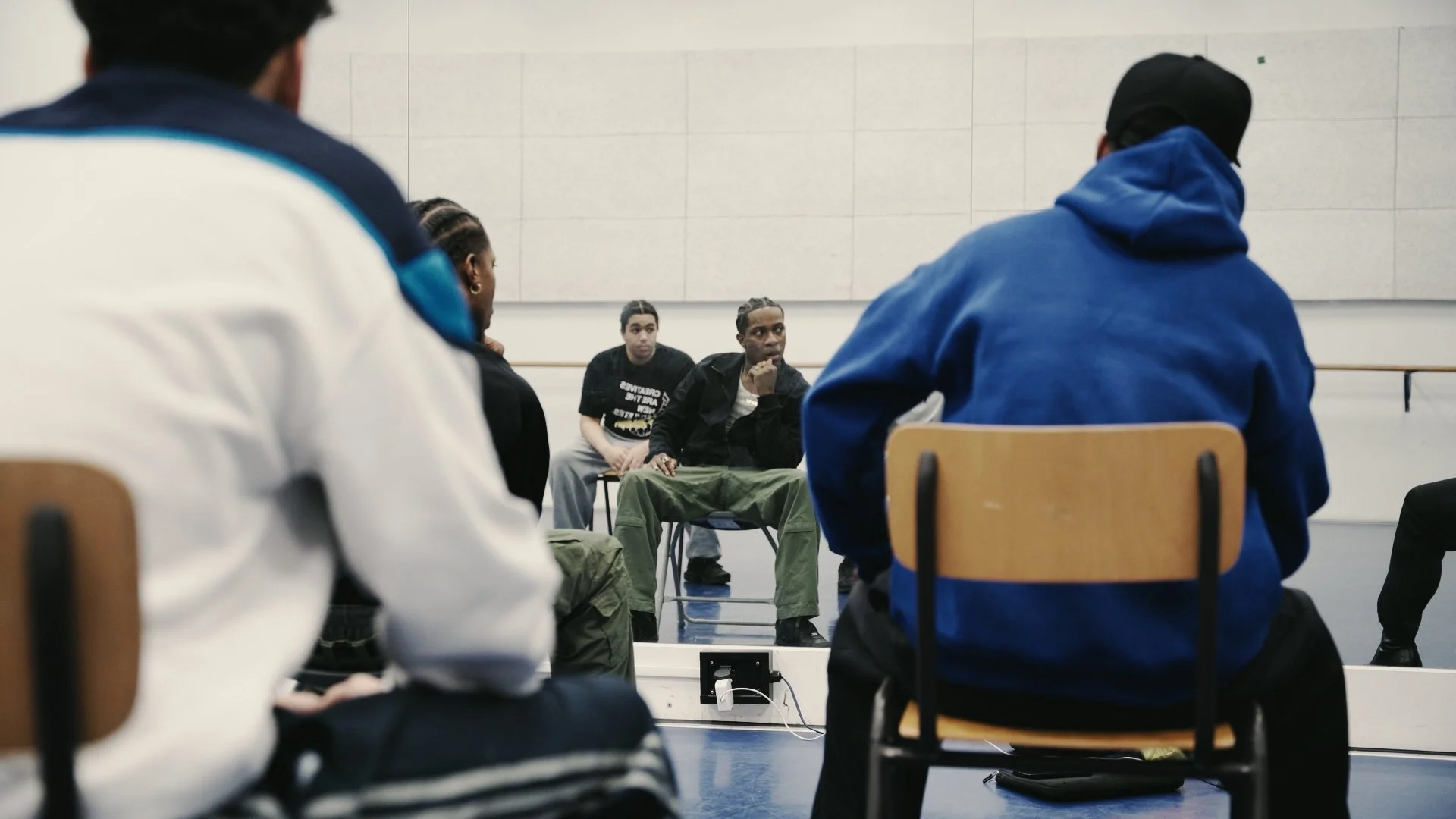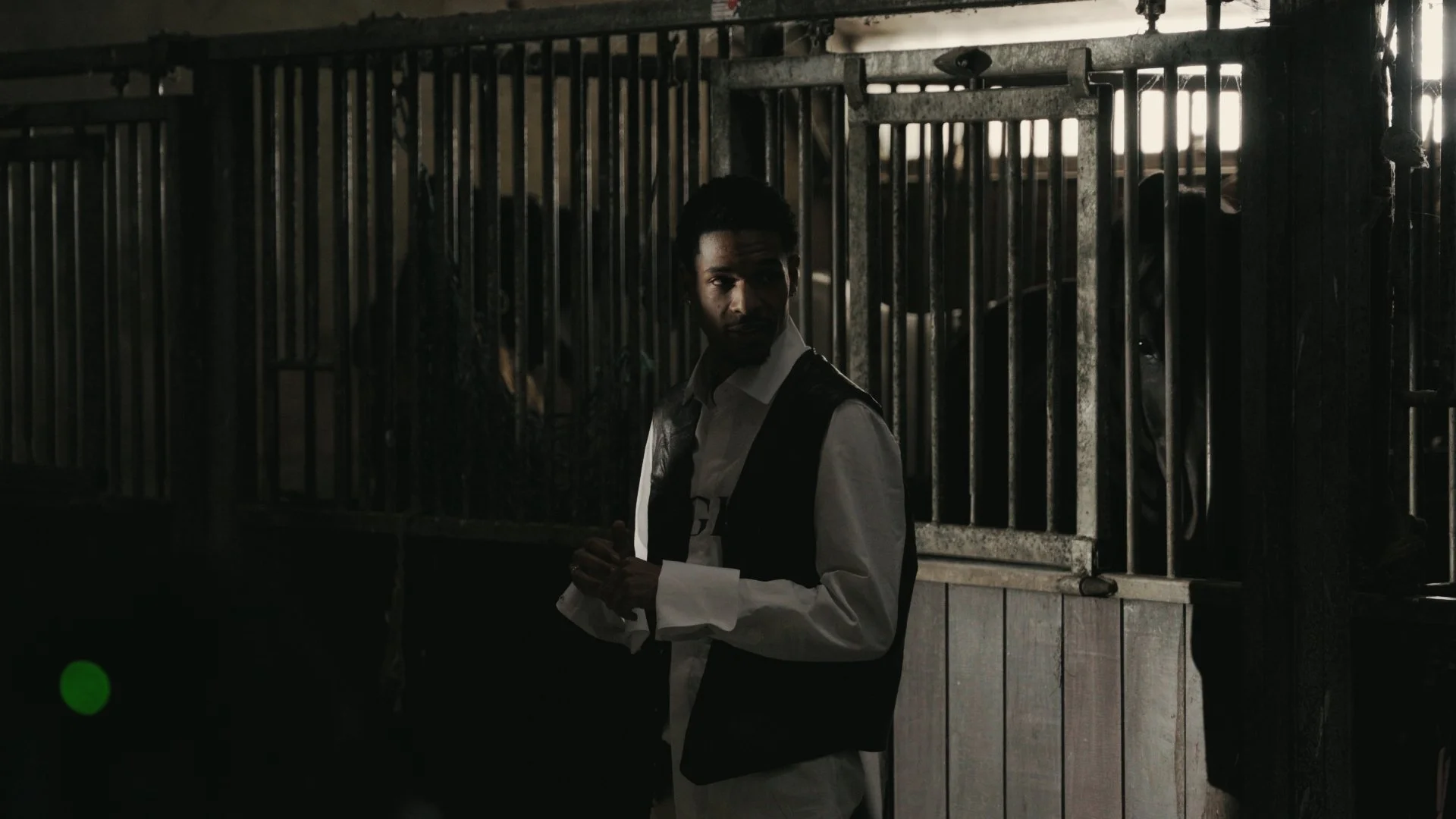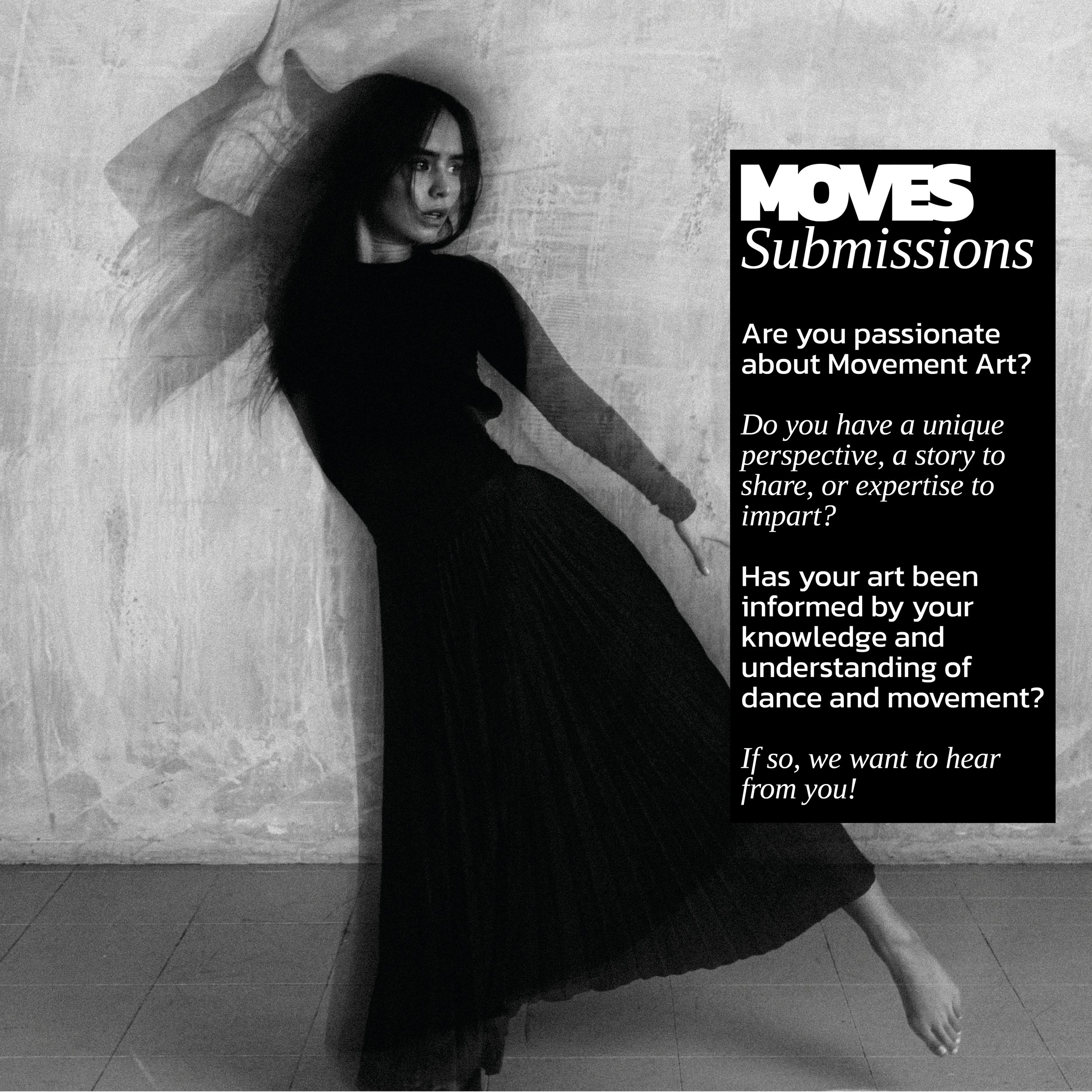
CREATING WHAT’S GOOD by robeathy corea: BEHIND THE SCENES OF A DANCE FILM
Words MIRANNE WATLEY
With choreography bareback on top of horses and detailed styling - think thick belt buckles and fur jackets - Robeathy Corea’s short dance film, What’s Good, is visually incredible. Released a year ago, What’s Good features eight dancers. The choreography (set to Tyler, The Creator) is intricate and fast-paced and there’s a playful awareness of the camera throughout. What’s Good blurs genres with the shadowy lighting and low angle shots of film noir and the hats, typography and, most obviously, horses of a Western.
Born in Lelystad, and now based in Amsterdam, Robeathy has danced on stages at The Louvre and The F1 Grand Prix as well as for artists such as Omah Lay and in the skeleton crew for Doechii. He also choreographs and teaches. While rooted in hip hop, his dancing fuses contemporary and jazz styles and, at the centre of every project, is his dedication to movement.
image MIJNTJE PLUGENS
For Robeathy, this passion for dance started at 15. First, performing Michael Jackson’s choreography to his family (carefully learnt from the music videos) before moving to bigger cities to continue more structured training. Robeathy was hooked by the “true joy” he found in dance.
What’s Good represented a new chapter for Robeathy. Pulling together different elements - dancing, cinematography, styling - allowed What’s Good to embody Robeathy’s distinct vision. He feels the film marked the “birth of something new… something people [hadn’t] seen from me yet”.
Now, MOVES is sharing the behind the scenes documentary of What’s Good. Taking viewers between the dimly lit streets of filming and the dance studio, the documentary shares a different side of the film. MOVES also had the chance to talk to Robeathy about his creative process and how this short film departed from his previous projects. “Everything was on a bigger scale”.
BTS documentary directed, filmed and edited by KYLIAN WEIJERS // Sound design by JURRIAAN KRUITHOFF
Featured dancers // ROBEATHY COREA / IBRAH JACKSON / MICHELE ZAN / KUTY OFF / DEVANTE WALDEN / NATHANIEL SAMPSON / REMI BLACK / JOLEY BINKEY
The song choice was at the core of this entire project. Can you discuss why you were drawn to Igor and, more specifically, What’s Good?
Tyler, The Creator is an artist that has had a major impact on my art, and Igor is one of his works that has stood by me for the longest. When I first heard the album I instantly knew that I had to create something on it.
What's Good was the song that resonated with what I was going through, personally, and the switch I was making in my career. Tyler is talking about that moment when you get your soul back. From your rock bottom moment to returning to yourself. Snapping out of it and talking your shit. Remembering who you are.
Why did you choose to incorporate the Western details into the film?
The Western details came from my idea to put African culture and movement in a space that you wouldn’t normally expect it to be - a farm with horses, old cars, and country fashion. I like the contrast because it shows that our style and energy can exist anywhere and still feel powerful. For me, the farm became a stage for pride, creativity, and storytelling.
The styling had to feel like part of the story, not just clothing. A big part of making that vision come to life was working with my stylist and close friend Josefine Herfst. We have worked together many times, and she always pushes the concept to another level.
Why do you think it’s important to share the behind the scenes of this project?
It’s a way of opening up the process so people can understand how much goes into it. I also want to inspire others who are working towards their own projects.
Especially with dance short films, it can be powerful to see the process and realise what it really takes to build something like this.
The process of choreographing What’s Good was really special to me because it actually started years ago, when I first heard the song. I remember the album dropping, and I was in the car with friends. When that track came on, I immediately asked them to replay it. While it was playing again, I was already envisioning raw, grimy movement in my head. I even recorded myself in the car right there. That video stayed with me for years and, when I finally decided to make What’s Good into a film, I went back to that recording and used it as a reference point.
I kept listening to the song over and over again in my own time, letting my body naturally translate the feeling of the music into movement.
Tell us about the process of choreographing What’s Good.
From there, I started developing a new version of the choreography that grew out of those first ideas. I worked closely with Raphael Duchenne during this process. I showed him the pieces I had, and he helped me connect everything together - making sure the transitions felt smooth and that the choreography worked as a whole. As a choreographer, it’s easy to make things that feel natural for myself, but I wanted to make sure that it was also comfortable for the group I was teaching. In that way, I used him almost like a skeleton to test the material before bringing it to the dancers.
Which part of the choreography was your favorite?
The transition from the street into the barn. That was the first moment where we really felt the shift into the farm’s energy. The music broke down there too, so from that point everything got a bit more serious and grimy. The street section was more of an introduction but once we hit the barn, with all the boys together in cowboy outfits, the whole vibe changed.
What did the other dancers bring to the set of What’s Good?
They were the key to What's Good. Their quality, execution, dedication, and patience… they embodied everything I asked from them and made it come to life. I built the movie around the dancers. We often see short films that are cinematic where dance is included, but it is not really highlighted. I wanted to change that and put dance at the centre. The only way to do that was through the dancers. They held everything together.
How did you prepare, both mentally and physically, for filming?
In all honesty, the preparation could have been better. I was so caught up trying to get it all together and me and Tracy (Head of Production) went through the entire process in detail. But while we were busy with all of that, I forgot to focus on myself and prepare mentally and physically. That is definitely something I will take with me next time.
What was the biggest challenge during filming?
We shot What’s Good in early June and, even though it was summer, nights in the Netherlands were still very cold. We were filming wrapped in blankets and fur coats and sitting in cars trying to stay warm.
On top of that, we only had a very small window to work with. Darkness started around 11 or 12 at night, and the sun was already coming up by 6 in the morning. We had to set up the lights, position the cameras, shoot the scenes, move equipment, reset the lights, and still find time for the dancers and crew to warm up and rest. It was tough because not only did everything have to be done quickly, but it also had to be done with quality.
That first night on the street was by far the hardest part of the process. The second day, at the farm, was much easier.



What do you hope audiences will take away from What’s Good?
I really hope the audience gets a deeper glimpse into me. Not just the dancer they might already know, but me as an artist exploring new ways of storytelling. This film is very personal because it shows a different side of my artistry. I want people to connect with me through this film, see my passion, and get a sense of the future projects I’m working towards.
Why do you feel it’s important to have a platform like MOVES to share creative projects on?
I feel like MOVES magazine is such an important platform for our community because it gives us the chance to share our art and be recognized. Not only by other artists but also by companies and brands. There are so many opportunities that a platform like MOVES can create.
For me, recognition and visibility are really important.
Of course, we make art for ourselves, but a lot of us also want to inspire others… and to be able to inspire, people need to actually see your work.
Personally, every time I’m on MOVES magazine, I see so many films, artists, and creative projects. I get inspired. That cycle of inspiration is what keeps our community alive and growing.
What advice would you give to other dancers looking to start working on films?
Plan everything in advance and make sure it’s scheduled properly. It saves you a lot of stress later on.
Once you’re actually on set, take your time with the filming process. You really want to invest your time and energy into the actual shots. That’s the most important part. If you rush through your shots you’ll end up in the editing room with material that you’re not happy with, and you can’t go back and reshoot once the day is done. It’s better to have fifty takes of one scene that are all high quality (and give you options!) rather than just a couple of rushed takes that don’t capture what you had in mind. While you’re filming, always do playbacks and check what you’ve shot so you know that you’re satisfied with it.
Prioritize the shots above everything else because they’re what carry the final product. Preparation matters, of course, but it’s mostly about time management. Get it done, keep it efficient, and save your energy for the camera work where it really counts.
For people who have enjoyed What’s Good, can you recommend other choreographers or videos that have inspired you?
The visuals that inspired me most for What’s Good were Kevin Bago’s - especially Backstabbers and Dance or Die. Also, all of the work from Gabriel Moses. They both really influenced how I look at visuals and how I bring movement into film.
Another big inspiration for me, more in terms of movement and work ethic, is Tyrik J. Patterson. I got to work with him on the skeleton of the Doechii Tour with Doja Cat in Los Angeles. During that time I got to see how he works up close and how disciplined and detailed he is. It really stuck with me.
Is there anything else you want to share about the process of creating What’s Good?
I just want to take a moment to really thank everyone for watching and for stepping into my world. It means so much to me and I don’t take any of this for granted. So I want to leave people with, simply, gratitude. Thank you for tapping in, for showing love, and for being a part of this journey with me.









